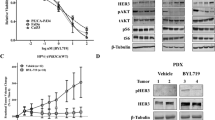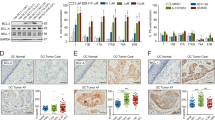Abstract
Background
STAT3 overexpression has been detected in several cancers including head and neck squamous cell carcinoma (HNSCC). Previous studies using intratumoral administration of a STAT3 decoy oligonucleotide that abrogates STAT3-mediated gene transcription in preclinical cancer models have demonstrated antitumor efficacy. This study was conducted to observe the toxicity and biologic effects of the STAT3 decoy in a non-human primate model, in anticipation of initiating a clinical trial in HNSCC patients.
Methods
Three study groups (two monkeys/sex/group) were administered a single intramuscular injection of low dose of STAT3 decoy (0.8 mg total dose/monkey), high dose of STAT3 decoy (3.2 mg total dose/monkey) or vehicle control (PBS alone) on day 1 and necropsies were performed on days 2 and 15 (one monkey/sex/group/day). Low and high doses of the decoy were administered in the muscle in a volume of 0.9 ml. Tissue and blood were harvested for toxicology and biologic analyses.
Results
Upon observation, the STAT3 decoy-treated animals exhibited behavior that was similar to the vehicle control group. Individual animal body weights remained within 1% of pretreatment weights throughout the study. Hematological parameters were not significantly different between the control and the treatment groups. Clinical chemistry fluctuations were considered within normal limits and were not attributed to the STAT3 decoy. Assessment of complement activation breakdown product (Bb) levels demonstrated no activation of the alternative pathway of complement in any animal at any dose level. At necropsy, there were no gross or microscopic findings attributed to STAT3 decoy in any organ examined. STAT3 target gene expression at the injection site revealed decreased Bcl-XL and cyclin D1 expression levels in the animals treated with high dose of STAT3 decoy compared to the animals injected with low dose of STAT3 decoy or the vehicle as control.
Conclusion
Based on these findings, the no-observable-adverse-effect-level (NOAEL) was greater than 3.2 mg/kg when administered as a single dose to male and female Cynomolgus monkeys. Plans are underway to test the safety and biologic effects of intratumoral administration of the STAT3 decoy in HNSCC patients.








Similar content being viewed by others
References
Barton BE, Karras JG, Murphy TF, Barton A, Huang HF (2004) Signal transducer and activator of transcription 3 (STAT3) activation in prostate cancer: direct STAT3 inhibition induces apoptosis in prostate cancer lines. Mol Cancer Ther 3:11–20
Bhasin D, Cisek K, Pandharkar T, Regan N, Li C, Pandit B, Lin J, Li PK (2008) Design, synthesis, and studies of small molecule STAT3 inhibitors. Bioorg Med Chem Lett 18:391–395
Bromberg JF, Wrzeszczynska MH, Devgan G, Zhao Y, Pestell RG, Albanese C, Darnell JE Jr (1999) Stat3 as an oncogene. Cell 98:295–303
Chan KS, Sano S, Kiguchi K, Anders J, Komazawa N, Takeda J, DiGiovanni J (2004) Disruption of Stat3 reveals a critical role in both the initiation and the promotion stages of epithelial carcinogenesis. J Clin Invest 114:720–728
Crooke RM, Graham MJ, Martin MJ, Lemonidis KM, Wyrzykiewiecz T, Cummins LL (2000) Metabolism of antisense oligonucleotides in rat liver homogenates. J Pharmacol Exp Ther 292:140–149
Darnell JE (2005) Validating Stat3 in cancer therapy. Nat Med 11:595–596
Dean NM, Bennett CF (2003) Antisense oligonucleotide-based therapeutics for cancer. Oncogene 22:9087–9096
Dudoit S, van der Laan MJ (2008) Multiple testing procedures with applications to genomics. Springer Science + Business Media New York, New York
Galbraith WM, Hobson WC, Giclas PC, Schechter PJ, Agrawal S (1994) Complement activation and hemodynamic changes following intravenous administration of phosphorothioate oligonucleotides in the monkey. Antisense Res Dev 4:201–206
Gao LF, Xu DQ, Wen LJ, Zhang XY, Shao YT, Zhao XJ (2005) Inhibition of STAT3 expression by siRNA suppresses growth and induces apoptosis in laryngeal cancer cells. Acta Pharmacol Sin 26:377–383
Grandis JR, Drenning SD, Zeng Q, Watkins SC, Melhem MF, Endo S, Johnson DE, Huang L, He Y, Kim JD (2000) Constitutive activation of Stat3 signaling abrogates apoptosis in squamous cell carcinogenesis in vivo. Proc Natl Acad Sci USA 97:4227–4232
Haura EB, Zheng Z, Song L, Cantor A, Bepler G (2005) Activated epidermal growth factor receptor-Stat-3 signaling promotes tumor survival in vivo in non-small cell lung cancer. Clin Cancer Res 11:8288–8294
Henry SP, Monteith D, Bennett F, Levin AA (1997) Toxicological and pharmacokinetic properties of chemically modified antisense oligonucleotide inhibitors of PKC-alpha and C-raf kinase. Anticancer Drug Des 12:409–420
Hoel AW, Conte MS (2007) Edifoligide: a transcription factor decoy to modulate smooth muscle cell proliferation in vein bypass. Cardiovasc Drug Rev 25:221–234
Hottiger MO, Felzien LK, Nabel GJ (1998) Modulation of cytokine-induced HIV gene expression by competitive binding of transcription factors to the coactivator p300. EMBO J 17:3124–3134
Jing N, Sha W, Li Y, Xiong W, Tweardy DJ (2005) Rational drug design of G-quartet DNA as anti-cancer agents. Curr Pharm Des 11:2841–2854
Jing N, Tweardy DJ (2005) Targeting Stat3 in cancer therapy. Anticancer Drugs 16:601–607
Lai SY, Childs EE, Xi S, Coppelli FM, Gooding WE, Wells A, Ferris RL, Grandis JR (2005) Erythropoietin-mediated activation of JAK-STAT signaling contributes to cellular invasion in head and neck squamous cell carcinoma. Oncogene 24:4442–4449
Leeman RJ, Lui VW, Grandis JR (2006) STAT3 as a therapeutic target in head and neck cancer. Expert Opin Biol Ther 6:231–241
Leong PL, Andrews GA, Johnson DE, Dyer KF, Xi S, Mai JC, Robbins PD, Gadiparthi S, Burke NA, Watkins SF, Grandis JR (2003) Targeted inhibition of Stat3 with a decoy oligonucleotide abrogates head and neck cancer cell growth. Proc Natl Acad Sci USA 100:4138–4143
Lui VW, Boehm AL, Koppikar P, Leeman RJ, Johnson D, Ogagan M, Childs E, Freilino M, Grandis JR (2007) Antiproliferative mechanisms of a transcription factor decoy targeting signal transducer and activator of transcription (STAT) 3: the role of STAT1. Mol Pharmacol 71:1435–1443
Mayr S, Welte T, Windegger M, Lechner J, May P, Heinrich PC, Horn F, Doppler W (1998) Selective coupling of STAT factors to the mouse prolactin receptor. Eur J Biochem 258:784–793
Mora LB, Buettner R, Seigne J, Diaz J, Ahmad N, Garcia R, Bowman T, Falcone R, Fairclough R, Cantor A, Muro-Cacho C, Livingston S, Karras J, Pow-Sang J, Jove R (2002) Constitutive activation of Stat3 in human prostate tumors and cell lines: direct inhibition of Stat3 signaling induces apoptosis of prostate cancer cells. Cancer Res 62:6659–6666
Novak EM, Metzger M, Chammas R, da Costa M, Dantas K, Manabe C, Pires J, de Oliveira AC, Bydlowski SP (2003) Downregulation of TNF-alpha and VEGF expression by Sp1 decoy oligodeoxynucleotides in mouse melanoma tumor. Gene Ther 10:1992–1997
Rubin Grandis J, Zeng Q, Drenning SD (2000) Epidermal growth factor receptor-mediated stat3 signaling blocks apoptosis in head and neck cancer. Laryngoscope 110:868–874
Sun Z, Yao Z, Liu S, Tang H, Yan X (2006) An oligonucleotide decoy for Stat3 activates the immune response of macrophages to breast cancer. Immunobiology 211:199–209
Takeda K, Noguchi K, Shi W, Tanaka T, Matsumoto M, Yoshida N, Kishimoto T, Akira S (1997) Targeted disruption of the mouse Stat3 gene leads to early embryonic lethality. Proc Natl Acad Sci USA 94:3801–3804
Tan M, Lan KH, Yao J, Lu CH, Sun M, Neal CL, Lu J, Yu D (2006) Selective inhibition of ErbB2-overexpressing breast cancer in vivo by a novel TAT-based ErbB2-targeting signal transducers and activators of transcription 3-blocking peptide. Cancer Res 66:3764–3772
Tomita N, Morishita R, Lan HY, Yamamoto K, Hashizume M, Notake M, Toyosawa K, Fujitani B, Mu W, Nikolic-Paterson DJ, Atkins RC, Kaneda Y, Higaki J, Ogihara T (2000) In vivo administration of a nuclear transcription factor-kappaB decoy suppresses experimental crescentic glomerulonephritis. J Am Soc Nephrol 11:1244–1252
Xi S, Gooding WE, Grandis JR (2005) In vivo antitumor efficacy of STAT3 blockade using a transcription factor decoy approach: implications for cancer therapy. Oncogene 24:970–979
Zhang X, Zhang J, Wang L, Wei H, Tian Z (2007) Therapeutic effects of STAT3 decoy oligodeoxynucleotide on human lung cancer in xenograft mice. BMC Cancer 7:149
Acknowledgment
This work was supported by the NCI RAID program, P50 CA097190, and R01 CA101840-01 (to JRG).
Author information
Authors and Affiliations
Corresponding author
Rights and permissions
About this article
Cite this article
Sen, M., Tosca, P.J., Zwayer, C. et al. Lack of toxicity of a STAT3 decoy oligonucleotide. Cancer Chemother Pharmacol 63, 983–995 (2009). https://doi.org/10.1007/s00280-008-0823-6
Received:
Accepted:
Published:
Issue Date:
DOI: https://doi.org/10.1007/s00280-008-0823-6




